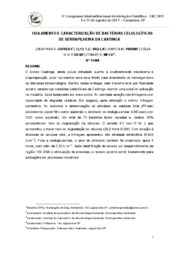Isolamento e caracterização de bactérias celulolíticas de serrapilheira da Caatinga.
Isolamento e caracterização de bactérias celulolíticas de serrapilheira da Caatinga.
Author(s): GIOVEDY, J. S.; VILELA, E. S. D.; PARMA, M. M.; SILVA, C. M. M. de S.; MELO, I. S. de
Summary: Resumo: O bioma Caatinga, ainda pouco estudado quanto a biodiversidade microbiana e bioprospecção, pode representar uma nova frente para descoberta de microrganismo de interesse biotecnológico. Dentro desse enfoque, este trabalho teve por finalidade isolar e caracterizar bactérias celulolíticas da Caatinga visando uma possível aplicação na indústria. Após isolamento em meio solido, foi realizada seleção das linhagens com capacidade de degradar celulose. Em seguida, após obtenção a melhor linhagem bacteriana, foi realizada a determinação da atividade de celulase total (FPase) adicionando papel filtro como substrato e atividade de endoglucanase (CMCase) com CMC como substrato. Um total de 73 bactérias foram isoladas e, destas, 34% apresentaram halo de degradação da celulose. O isolado 6.1 bac-15 foi o que apresentou o maior halo de degradação de celulose (29,5 mm± 0,288). Com relação à atividade de celulase total, a linhagem apresentou alta atividade enzimática (0,043 U.ml-1). Para a endoglucanase, o pico de atividade também foi observado após 4 horas, com valor de 0,80 U.ml-1. Após identificação do isolado por sequenciamento da região 16S DNA e otimização do processo, o isolado poderá servir futuramente para aplicações em processos industriais. Abstract: The Bioma Caatinga (white forest) which can be useful for biotechnological purposes can harbor thermotolerant microorganism by use biotechnology. This study was conducted to isolate and evaluate bacteria able to degrade cellulose obtained from semiarid region, in northeast Brazil. After the isolation, it was conduced the screening of strains for their ability to degrade cellulose in solid medium with carboxymethylcellulose (CMC). After the selection of the best isolate; the determination of total cellulase activity in filter paper (FPase) and endoglucanase (CMCase) on CMC as substrate was performed. A total of 73 bacteria were isolated and among them, 34% showed degradation of the polymer when stained with Gram iodine solution. The isolate 6.1 bac-15, showed the largest cellulose degradation halo (29,5 mm± 0,288). Regarding activity of the total cellulase, after a 4 hour-period incubation, the highest enzyme activity was observed (0,043 U.ml-1). For endoglucanase, the highest activity was also observed after 4 hours, with value of 0,80 U.ml-1. After the identification of the strain by sequencing of 16S DNA and optimization of the process, this bacterial stain could serve for future applications in industrial processes.
Publication year: 2011
Types of publication: Paper in annals and proceedings
Unit: Embrapa Environment
Keywords: Bactéria, Cellulolytic microorganisms, Celulase
Observation
Some of Embrapa's publications are published as ePub files. To read them, use or download one of the following free software options to your computer or mobile device. Android: Google Play Books; IOS: iBooks; Windows and Linux: Calibre.
Access other publications
Access the Agricultural Research Database (BDPA) to consult Embrapa's full library collection and records.
Visit Embrapa Bookstore to purchase books and other publications sold by Embrapa.

